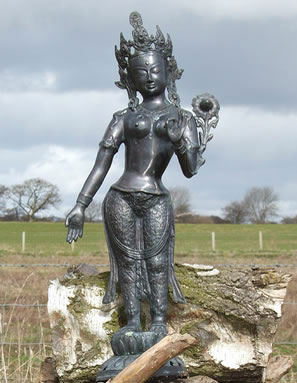Green Tara mantra
The Bodhisattva-Goddess Tara (or Tara)
Tara means "star," "planet," or "she who ferries across." She is a bodhisattva embodying compassion in the female form of a young goddess. She is often considered to be such an advanced bodhisattva that she is actually a Buddha.
Tara's name is said to derive from the verb meaning "to cross" or "to traverse". In Pali the verb tarati means "to get to the other side." This word is cognate with the Latin "trans" (across). The word Tara also literally means "star."

Standing Tara statue at Taraloka (FWBO Photos)
An interesting overlap between these two senses is the use of stars in navigation. The Pole Star, used at least for millennia to guide travelers, was known as Dhruva-Tara (the immovable star). Tara becomes a focal point on the far shore that helps us guide our lives in a safe direction. We can take her enlightened qualities of wisdom and compassion as our guide, moment by moment, as we navigate our lives.
A third meaning of "tara" is "the pupil of the eye," again suggesting a focal point and conveying a sense that Tara watches over those who navigate the treacherous waters of life in search of the further shore of liberation.
Tara's name in Tibetan is Dolma, which means "She Who Saves." She is seen as guarding against the Eight Great Terrors of lions, elephants, fire, snakes, robbers, imprisonment, shipwreck or drowning, and man-eating demons. In each case these terrors are symbolic of spiritual dangers. For example, the First Dalai Lama described the demons against which Tara offers protection as being our self-consuming spiritual doubts.
www.wildmind.org/mantras/figures/greentara/2/
